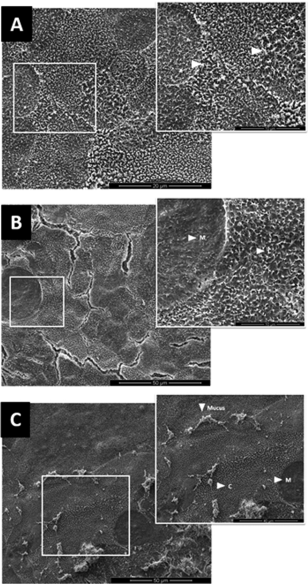RECENT PUBLICATIONS: In vitro M-like cells genesis through a tissue-engineered triple-culture intestinal model
INEB researchers recently published an article in the Journal of Biomedical Materials Research, Part B - Applied Biomaterials, available since August 2015. The article is entitled "In vitro M-like cells genesis through a tissue-engineered triple-culture intestinal model" and is authored by Araújo, F; Pereira, C; Costa, J; Barrias, C; Granja, PL and Sarmento, B.

Figure 1: Scanning electron micrographs after 21 days of culture. (A) In the Caco-2 model, a Caco-2 monolayer with a homogeneous and fully differentiated phenotype was evidenced by the presence of microvilli (arrows). (B) In the Caco-2/Raji B model, M-like cells (M) presented shorter microvilli. (C) In the Caco-2/HT29-MTX/Raji B model, besides the presence of M cells (M), evidence of residual mucus attached to the microvilli was also found.
Although fewer in number, M-cells are considered antigen sampling cells, acting as a gateway for antigens from the gut lumen and presenting an impressive aptitude for particle transcytosis. These features make M-cells attractive targets for oral drug delivery studies, but this has been poorly explored. New and reproducible tissue-like in vitro models for studying intestinal sampling and permeability mechanisms are needed. The combination of different cell players in such models offers improved microenvironments with higher physiologic relevance. Here, a tissue-engineered model was established, by co-culturing Caco-2 absorptive cells, HT29-MTX mucus-producing cells and Raji B lymphocytes. Ultimately, the proposed tissue-engineered model provides a more complete and reliable tool to perform drug permeability tests, as compared to traditional models, and may also find applicability as an in vitro system to study transdifferentiation mechanisms of M cells.


